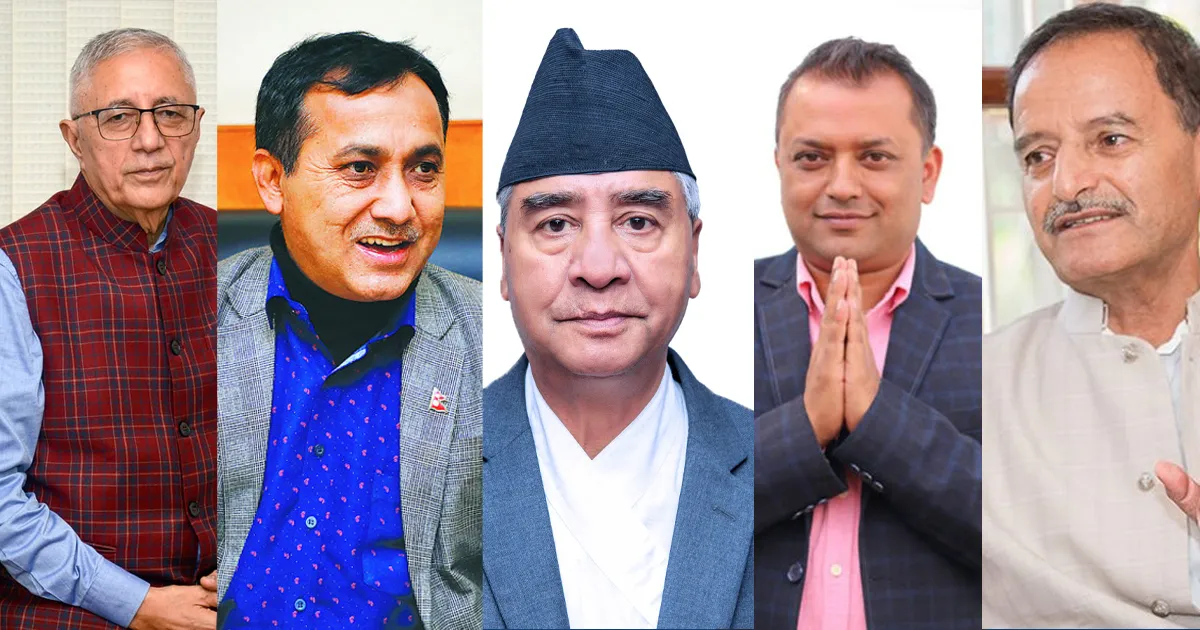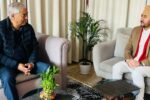KATHMANDU: In the labyrinth of Nepali Congress (NC) politics, the faction-sub-faction dynamics are in constant flux, leaving even the party leaders perplexed about their allegiances and rivalries.
Despite the factional maneuvering, the ultimate triumph often aligns with the leader of the establishment faction, Sher Bahadur Deuba, as evident from the Nepali Congress convention and the parliamentary party leadership elections.
Gagan Thapa, a key figure in the Dr. Shekhar Koirala group during the 14th Congress, finds himself at odds with Shekhar’s leadership post-election.
Concurrently, rumors circulate within the NC circles, hinting at Thapa’s intention to form another faction, potentially including prominent leaders like central member Pradeep Poudel and General Secretary Bishwa Prakash Sharma.
However, these leaders deny any knowledge of such a development.
According to second-tier Nepali Congress leaders, the strained relationship between Bishwa and Gagan adds complexity to the potential formation of a new faction.
While some senior Nepali Congress leaders advocate for political experience over leadership transition, a faction comprising influential figures like Gagan, Bishwa Prakash, Pradeep Paudel, and Chandra Bhandari is actively campaigning for party reform, challenging the traditional hierarchy.
Some argue that even if a faction emerges, its impact might be limited.
Investigations reveal a rift between Gagan and Shekhar, who initially led a separate faction within the party.
While Deuba stands as the flagbearer of the establishment side, Dr. Koirala heads the other faction.
Gagan, once closely aligned with Shekhar Koirala, contemplates breaking away to establish a distinct group following the Congress parliamentary party elections.
During the last election in the General Convention, Dr. Koirala secured leadership with 32 votes from his faction, whereas Gagan faced a setback, receiving only 25 votes, contrasting with the robust support of 64 votes for party President Deuba. This fortified Deuba’s dominance in the 89-member Congress parliamentary party.
Some members of the Dr. Koirala faction contend that Thapa’s defeat was not a fair representation of the votes.
In response to his defeat, Gagan stated, “Even though the result was unexpected, I took it as a matter of course.”
He voiced concerns about decision-making transparency within the party, emphasizing the need for discussions within relevant committees rather than decisions made behind closed doors.
Thapa’s criticism of the leadership began in the aftermath of the parliamentary party election, signaling potential upheaval within the Congress ranks.
Dynamics Behind the Congress Rift
As the Nepali Congress gears up for the upcoming Mahasamiti meeting, speculations abound regarding a potential shift in the party’s approach through a policy convention.
The Congress Executive Committee to be held soon is likely to pave the way for the crucial Mahasamiti meeting scheduled from January 1-4, 2024, with the National Assembly elections looming in January.
However, the political landscape within the Congress took an unexpected turn on December 12 when the Koirala-led faction held a meeting, excluding key figures like Gagan and Bishwa Prakash.
This move raised eyebrows, particularly given that Gagan had previously skipped a Baluwatar meeting called by Shekhar Koirala two months prior.
A senior Congress leader shed light on the situation, explaining, “There was an invitation to the meeting held two months ago in Baluwatar. This time, we did not call after Bishwa Prakash Sharma said he would not come. The matter about Gagan is different.”
The leader indicated a deliberate exclusion of Gagan from the recent meeting, suggesting a divergence in principles and loyalty.
According to a trusted source within the Shekhar faction, there was a debate about whether Gagan should be invited, ultimately leading to the meeting’s postponement to Wednesday.
Amid this internal strife, questions arise about Gagan’s previous electoral promise to become Prime Minister.
In the 2079 House of Representatives election, Gagan, standing from Kathmandu-4, garnered support by pledging party leadership during a period of transition.
Despite winning, he has yet to fulfill this commitment, causing a stir within the party.
While some second-generation Congress leaders claim to be unaware of Deuba’s assurances to Sitaula, the intricate web of alliances and positioning among the party’s stalwarts suggests that the Nepali Congress is undergoing a complex period of transition and power realignments.
While some senior Nepali Congress leaders advocate for political experience over leadership transition, a faction comprising influential figures like Gagan, Bishwa Prakash, Pradeep Paudel, and Chandra Bhandari is actively campaigning for party reform, challenging the traditional hierarchy.
The departure of intellectual leader Swarnim Wag to a new party, Rastriya Swatantra Party (RSP), citing repression within the Nepali Congress, further underscores the urgency for change, particularly in providing opportunities for the youth.
Dynamics of Loyalty
In the Nepali Congress party, a clear divide is emerging between the seasoned, older leaders who rally behind NC President Deuba, and the anticipation of factional shifts in the upcoming 15th party convention.
Prominent figures such as Bimalendra Nidhi, Shashank Koirala, and Prakashman Singh are staunch supporters of NC President Deuba.
This consolidated support from seasoned leaders forms a formidable backing for Deuba’s leadership.
Contrarily, some party leaders foresee an imminent polarization during the 15th party convention.
Joint General Secretary Bhishmaraj Angdambe predicts that factions will splinter further into sub-factions by the time of the 15th convention, emphasizing the competitive nature among party members striving for power.
Angdembe asserts that President Deuba’s blessings are crucial for anyone aspiring to ascend within the party ranks, claiming, “The president wants to go in a new way,” as he asserts his influence over influential leaders in the Congress.
Likewise, NC leader Maha Laxmi Upadhyaya underscores the prevalence of factionalism in the party due to its financial strength, history, and heritage.
Despite the diversity of ideologies within large parties, she highlights the unwavering acceptance of decisions made by President Deuba within the Congress.
The political lineage within the Congress is evident with Shashank Koirala, the son of BP Koirala, holding the position of General Secretary.
Similarly, Prakashman Singh (Ganeshman’s son) vied for the Vice President post in the 14th convention.
Bimalendra Nidhi, Dr. Shekhar Koirala, and Purna Bahadur Khadka, all candidates for leadership roles, align in their support for President Deuba.
Interestingly, Ram Chandra Paudel, who initially claimed to endure extreme oppression by NC President Deuba in the 14th convention, has been appointed President under Deuba’s initiative.
This move raised questions among the younger Nepali Congress leaders about the potential positions for other veteran leaders like Krishna Prasad Sitaula.
There are speculations that Sitaula may be nominated for a position in the National Assembly.
Sitaula reportedly has aspired to become the Chairman of the National Assembly, a post that NC President Deuba is allegedly considering offering him.
The National Assembly member election will be a crucial moment for these internal political maneuverings within the Congress.
While some second-generation Congress leaders claim to be unaware of Deuba’s assurances to Sitaula, the intricate web of alliances and positioning among the party’s stalwarts suggests that the Nepali Congress is undergoing a complex period of transition and power realignments.








Comment